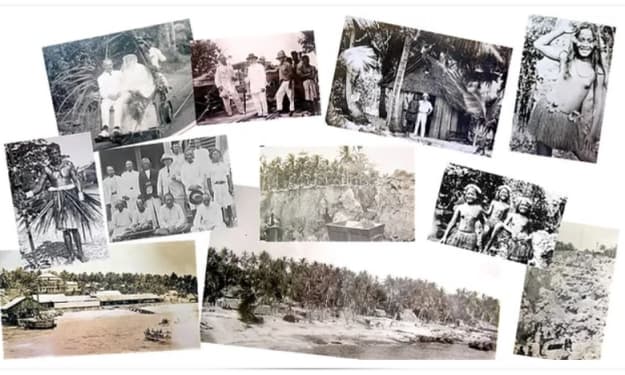
Stacey King
Bio
Stacey King, a published Australian author and historian. Her writing focuses on her mission to build global awareness of the plight of the indigenous Banaban people and her achievements as a businesswoman, entrepreneur and philanthropist.
Stories (25/0)
Banaban Landowners Visit their homeland
This 'Snippet’ of Ocean Island history was supplied by Banaban Heritage Society (BHS) [1] member, Marion Laritz from an article written by a fellow Island resident, Mr. R. Williams and published in the local newsletter, The Nautilus, Volume 2, Edition 3, November 1967.
By Stacey King5 months ago in History
Ocean Island Kart Club
The following ‘snippet’ was from Banaban Heritage Society member Brian Bailey about the introduction of go-kart racing and the set-up of the Ocean Island Kart [1] Club during the 1960s. His story appeared in 'A Snippet From the Past", Banaba/Ocean Island News, Issue No. 12 (Nov-Dec 1994) [2]
By Stacey King5 months ago in History
Returning to Ocean Island-Post War
Joan Ramsay from New Zealand, was one of the first European women to return to Ocean Island Post War. Her husband was working for the Gilbert & Ellice Island Colony (GEIC) [1] government. Her story is adapted from a radio interview she gave for NZ radio about her life spent on the islands.
By Stacey King5 months ago in History
Imminent Peril: Ocean Island on the Brink of Invasion
Maureen White was seventeen years old and one of the people who survived the sinking of the British Phosphate Commission (BPC) ship, SS TRIONA, by German Raiders prior to the evacuation of Banaba—known during the phosphate mining period as Ocean Island. Maureen and her mother, Letitia, were taken prisoners by the Germans before being released on a remote island in New Guinea.
By Stacey King5 months ago in History
Shipwrecks of Ocean Island / Banaba: PART TWO
The following information was provided by Captain Brant, Master of SS ROWANBANK, which loaded phosphate at Ocean Island (Banaba) on 20 April 1967. It was a sentimental journey recalling his time as serving as second mate aboard SS TITENBANK which sailed from Nauru to Ocean Island to stand by at the time SS KELVINBANK went on the reef 14 years before. Captain Brant supervised the salvaging of Bank Line stores from the stricken ship." [1]
By Stacey King5 months ago in History
Shipwrecks of Ocean Island / Banaba: PART ONE
The following information was provided by the late British Phosphate Commission (BPC) employee, Roger Anderson. The original article was written by Captain John Marine Fisk. Captain Fish had been Master of one of the BPC charter ships, KOMATA, which was sun at Nauru by the German Raiders in December 1940. He became the master of the RIVER BURDEKIN that liberated Nauru and Banaba after the War. [1]
By Stacey King5 months ago in History
Come Meet the Banabans
The Come Meet the Banabans [1] website was first created and launched in 1993 by Australian woman, Stacey King. The Banaban people are the indigenous inhabitants from a small remote Pacific Island, originally called Ocean Island. Today the Island is known by its indigenous name - Banaba.
By Stacey King5 months ago in History
Banaban Tradition of Frigate Bird Snaring / Taming
Today, the majority of the Banaban community resides on Rabi Island, Fiji, with only around 300 Banabans inhabiting their homeland in the Kiribati Islands group. The traditional Banaban ritual of te kabwane eitei, also known as frigate bird snaring, has been lost due to various factors. These include the introduction of Christianity in the late 1980s, the arrival of te I-Matang's (Europeans) in 1900 following the discovery of phosphate, and the forced removal of Banabans from their homeland by invading Japanese forces in 1943 during World War II.
By Stacey King5 months ago in FYI
The Authors' Story behind Te Rii ni Banaba - Backbone of Banaba
The first thought that comes to mind when you meet this unusual couple… is how did they ever end up together? Stacey King appears as your average blond Australian businesswoman who has learned the hard way what it is like to compete in Australia’s tough male-dominated business world, while Raobeia (Ken) Sigrah, with his dark coffee-coloured skin, strong chiselled face, and sinewy body, has a habit of greeting total strangers with such warmth and his infectious smile that he immediately takes people off guard. To see them together, they are obviously in love, a team, but how on earth did they ever meet?
By Stacey King10 months ago in History
Words of Banaban War Chant
A Dance Inciting Warriors to Battle [1] The chant Emananga emanangananga is part of a much longer chant used in the historic Te Karanga. It is a preface to war. Among its cries is IA IA E MATE (the enemy is already dead). This shows that it probably has been used as a coercive chant that will bring victory to the Banaban against their enemies.
By Stacey King2 years ago in FYI













